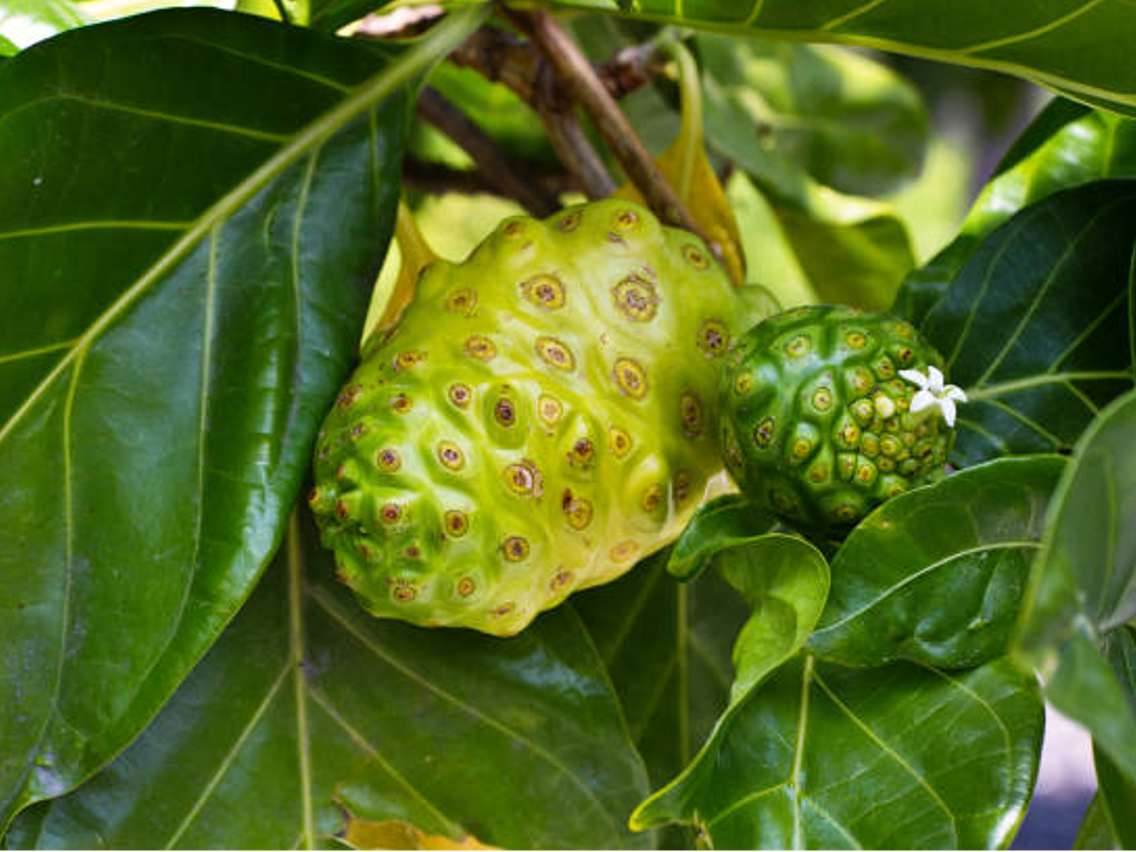Noni - Great Morinda

Common Names: Great morinda, Indian mulberry, beach mulberry, cheese fruit, Morinda citrifolia, Noni, Mengkudu, Ba Ji Tian, Fruta del diablo, Morinda officinalis, noni fruit, nausea plant, hog apple
Latin Name: Morinda citrifolia
Origin: Africa, Asia, Australia, Europe, South America, North America
Short Introduction
Before sowing, noni seeds should be properly germinated. It is also advisable to soak the seeds in lukewarm water for 1–2 days beforehand. Afterwards, keep the seeds in a warm and moist environment for several weeks. The germination period of noni is highly variable, ranging from about 10 to 100 days. Once sprouted, simply transfer the seedlings into a peat substrate. As for the environment, noni should be planted in sunny, well-ventilated locations. With favorable outdoor conditions, noni will grow faster and more efficiently. In summer, an optimal temperature is around 30°C (86°F); in winter, a temperature slightly above 18°C (64°F) without direct sunlight is sufficient.
Detailed Description
This plant is renowned for its significant positive influence on the body’s natural immunity.
Botanical Information
Great Morinda is a tropical shrub that can grow up to 9 meters tall, though it often stays shorter. The plant is remarkably resilient, thriving both in shaded forests and open, sunlit spaces with rocky or sandy soils. Great Morinda can even survive in arid regions, volcanic areas, lava flows, rocky outcrops, or soils with high salt concentrations.
The inflorescence and fruit clusters are compound. The plant attracts a special type of ant that builds nests from noni leaves and protects the plant year-round from parasitic insects, without damaging the plant itself.
Traditional medicine makes use of the noni fruit, which is produced several times a year. The plant reaches fertility around 18 months of age, after which it can bear 4–8 kg of fruit per month. The fruit is about 10–20 cm in diameter and contains many seeds. Unripe fruit is green, turning yellow as it matures, and ripened fruit is yellowish-white to white.
In some cultures, noni fruit is called "starvation food" because it has historically been eaten during times of famine or as a regular part of the diet—consumed fresh or cooked. Inhabitants of Southeast Asia and Australia eat salted, roasted noni and fry its seeds.
Origin and Distribution
Great Morinda is believed to originate from Southeast Asia and Australasia, naturally occurring across the Indian Ocean region through Indonesia and as far as Hawaii. Today, noni is widespread and cultivated throughout the tropics, where it has naturalized. Its largest commercial cultivation is on Hawaiian farms, which rely heavily on noni production, and where the fruit’s beneficial effects are most extensively studied in academic circles.
Usage / Dosage
Noni has been used in traditional medicine for an estimated 2,000–2,500 years, lauded for its tremendous health benefits. Multiple studies suggest clear advantages of noni in traditional healing practices.
A 2012 study assessed the daily consumption of noni juice for its impact on cardiovascular health, monitoring LDL, HDL, and homocysteine (an inflammatory marker). After one month, results suggested noni could significantly lower LDL, moderately increase HDL, and reduce homocysteine levels.
Noni appears beneficial in the management of diabetes and elevated blood glucose, with studies showing a noteworthy reduction in blood sugar and glycated hemoglobin compared to diabetic controls. Noni also stimulates genetic expression of proteins related to sugar metabolism and enhances glucose uptake by peripheral tissues.
Animal studies demonstrated that morinda extract provoked a 36% increase in white blood cell production and about a 33% rise in anti-inflammatory marker expression, indicating immunostimulatory and notable antibiotic-like effects.
The noni fruit is traditionally used to address conditions such as arthritis, diabetes, high blood pressure, musculoskeletal pain, menstrual problems, atherosclerosis, heart concerns, and headaches. Juice from the leaves acts as a natural antiseptic/disinfectant. Noni seeds contain a significant amount of linoleic acid, making them suitable for external use on inflamed, acne-prone, and oily skin.
Research has established that noni is safe for consumption, and has shown antioxidant, anti-inflammatory, and apoptosis-inducing (regulated cell death) properties. Therefore, noni is considered a potential complementary candidate for therapy alongside chemotherapy drugs.
Active Compounds
Great Morinda fruit is rich in carbohydrates and fiber, which contribute significantly to its nutritional value. It contains about 6% protein, 30–40% fiber, and 1–2% fat. Other key nutrients include vitamin C, vitamin B3 (niacin), iron, and potassium, along with smaller amounts of vitamin A, calcium, and sodium. Fresh fruit is typically richer in these nutrients than juice, though both have similar nutritional profiles. Some additional compounds—including catechin and epicatechin flavonoids—contribute further health benefits. Noni contains unique endemic compounds such as xeronine, damnacanthal (dacanthal), and stigmasteryl.
Traditional Dosage
Dosage varies with the nature and course of the condition. Generally, usage is divided into phases: an initial loading phase of about 3 days, with 1 tablespoon (about 4g) twice daily before meals. The following phase lasts 1 month with a doubled dose, taken in the same regimen. The final phase, lasting 2–4 months, involves doubling just the morning dose while maintaining the evening dose. Long-term use is recommended, especially for immune support. For cancer patients, dosing and duration should always be consulted with a healthcare provider or by referencing professional resources.
